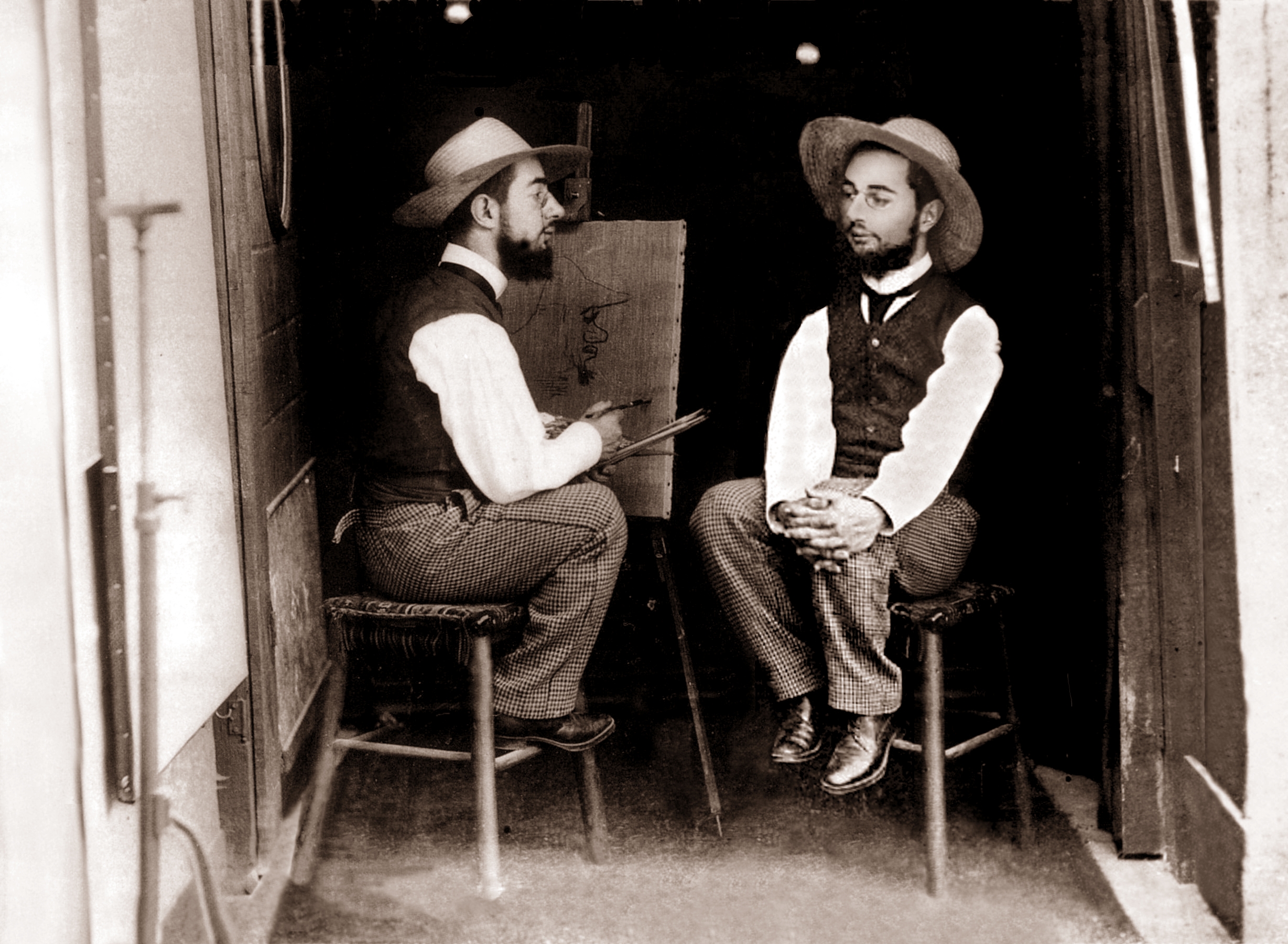|
Henri De Toulouse-Lautrec
Count, ''Comte'' Henri Marie Raymond de Toulouse-Lautrec-Monfa (24 November 1864 – 9 September 1901), known as Toulouse-Lautrec (), was a French painter, printmaker, draughtsman, caricaturist, and illustrator whose immersion in the colourful and theatrical life of Paris in the late 19th century allowed him to produce a collection of enticing, elegant, and provocative images of the sometimes decadent affairs of those times. Born into the aristocracy, Toulouse-Lautrec broke both his legs during adolescence, leaving him with a stunted appearance. In later life, he developed an affinity for brothels and prostitutes that directed the subject matter for many of his works, which record details of the late-19th-century bohemian lifestyle in Paris. He is among the painters described as being Post-Impressionism, Post-Impressionists, with Paul Cézanne, Vincent van Gogh, Paul Gauguin, and Georges Seurat also commonly considered as belonging in this loose group. In a 2005 auction at ... [...More Info...] [...Related Items...] OR: [Wikipedia] [Google] [Baidu] |
Count Alphonse De Toulouse-Lautrec Montfa
Count, Comte Alphonse de Toulouse-Lautrec Montfa (1838–1913) was a French aristocrat. A noted eccentric and fancier of horses, hawks, hunting, and kites, he was a "man out of time", whose vast wealth and royal connections allowed him to ignore convention. Once, the count appeared uninvited at a parade in Paris, riding in a Norwegian cart pulled by a Welsh pony, while flying a French Man-lifting kite, war-kite. When the parade officer protested, the enraged count challenged him to a duel. Both men fired their weapons and missed. Another time, he rode a mare in milk to the Cascade at the end of the Bois de Boulogne, milked the horse, and drank the milk for breakfast. He gave his pet hawks and cormorants holy water in the hope that they would go to heaven. He held little regard for his son Henri de Toulouse-Lautrec, Henri, who became a famous painter and poster artist, but could not ride a horse. Life Born in Albi on 10 August 1838, Alphonse de Toulouse-Lautrec Montfa was the son ... [...More Info...] [...Related Items...] OR: [Wikipedia] [Google] [Baidu] |
Albi
Albi (; ) is a commune in France, commune in southern France. It is the prefecture of the Tarn (department), Tarn Departments of France, department, on the river Tarn (river), Tarn, 85 km northeast of Toulouse. Its inhabitants are called ''Albigensians'' (, ). It is the seat of the Roman Catholic Archdiocese of Albi, Archbishop of Albi. The episcopal city, around the Albi Cathedral, Cathedral Sainte-Cécile, was added to the UNESCO list of World Heritage Sites in 2010 for its unique architecture. The site includes the Musée Toulouse-Lautrec, dedicated to Henri de Toulouse-Lautrec, the artist who was born in Albi. Administration Albi is the seat of four Canton in France, cantons, covering 16 Commune in France, communes, with a total population of 72,416 (2019). History The first human settlement in Albi was in the Bronze Age (3000–600 Before Christ, BC). After the Ancient Rome, Roman conquest of Gaul in 51 BC, the town became ''Civitas Albigensium'', the territor ... [...More Info...] [...Related Items...] OR: [Wikipedia] [Google] [Baidu] |
Georges Seurat
Georges Pierre Seurat ( , ; ; 2 December 1859 – 29 March 1891) was a French post-Impressionist artist. He devised the painting techniques known as chromoluminarism and pointillism and used conté crayon for drawings on paper with a rough surface. Seurat's artistic personality combined qualities that are usually thought of as opposed and incompatible: on the one hand, his extreme and delicate sensibility, on the other, a passion for logical abstraction and an almost mathematical precision of mind. His large-scale work '' A Sunday Afternoon on the Island of La Grande Jatte'' (1884–1886) altered the direction of modern art by initiating Neo-Impressionism, and is one of the icons of late 19th-century painting. Biography Family and education Seurat was born on 2 December 1859 in Paris, at 60 rue de Bondy (now rue René Boulanger). The Seurat family moved to 136 boulevard de Magenta (now 110 boulevard de Magenta) in 1862 or 1863. Seurat: p. 16 His father, Antoine Chrysost ... [...More Info...] [...Related Items...] OR: [Wikipedia] [Google] [Baidu] |
First Cousins
A cousin is a relative who is the child of a parent's sibling; this is more specifically referred to as a first cousin. A parent of a first cousin is an aunt or uncle. More generally, in the kinship system used in the English-speaking world, cousins are in a type of relationship in which the two cousins are two or more generations away from their most recent common ancestor. In this usage, "degrees" and "removals" are used to specify the relationship more precisely. "Degree" measures how distant the relationship is from the most recent common ancestor(s), starting with one for first cousins and increasing with every subsequent generation. If the cousins do not come from the same generation, "removal" expresses the difference in generations between the two cousins. When no removal is not specified, no removal is assumed. Various governmental entities have established systems for legal use that can precisely specify kinship with common ancestors any number of generations in ... [...More Info...] [...Related Items...] OR: [Wikipedia] [Google] [Baidu] |
Guibert 2
Guibert is a given name and surname, and may refer to: ; Given name *Saint Guibertus of Gorze (892-962 AD), ex-noble hermit and founder of Gembloux Abbey * Guibert of Ravenna (or Wibert of Ravenna; {{c.}), Italian Roman Catholic archbishop of Ravenna, elected Antipope Clement III * Guibert of Gembloux (10th century), founder of the Abbey of Gembloux *Guibert of Nogent (c. 1055–1124), Benedictine author and theologian * Guibert of Tournai (13th century), Franciscan theologian *Maistre Guibert Kaukesel, or Hubert Chaucesel (fl. c. 1230–55), French trouvère from Arras * Guibert of Cors (died 1258), French knight and Baron of Mitopoli in the Principality of Achaea ; Surname * André Guibert (1886-1966), French psychiatrist and psychoanalyst * Andres Guibert (born 1968), Cuban basketball player * Élisabeth Guibert (1725–1788), French Actor * Emmanuel Guibert (born 1964), French general in war * Georges Guibert (1915–1997), French Roman Catholic missionary in Senegal and Réu ... [...More Info...] [...Related Items...] OR: [Wikipedia] [Google] [Baidu] |
Nobility Of France
The French nobility () was an aristocratic social class in France from the Middle Ages until its abolition on 23 June 1790 during the French Revolution. From 1808 to 1815 during the First Empire the Emperor Napoléon bestowed titles that were recognized as a new nobility by the Charter of 4 June 1814 granted by King Louis XVIII of France. From 1814 to 1848 (Bourbon Restoration in France and July Monarchy) and from 1852 to 1870 (Second French Empire) the French nobility was restored as a hereditary distinction without any privileges and new hereditary titles were granted. Since the beginning of the French Third Republic on 4 September 1870 the French nobility has no legal existence and status. However, the former authentic titles transmitted regularly can be recognized as part of the name after a request to the Department of Justice. Families of the French nobility could have two origins as to their principle of nobility: the families of immemorial nobility and the ennobl ... [...More Info...] [...Related Items...] OR: [Wikipedia] [Google] [Baidu] |
Courtesy Title
A courtesy title is a title that does not have legal significance but is rather used by custom or courtesy, particularly, in the context of nobility, the titles used by children of members of the nobility (cf. substantive title). In some contexts, ''courtesy title'' is used to mean the more general concept of a title or honorific such as Mr., Mrs., Ms., Miss, Madam, Sir for those who not been awarded a knighthood or a baronetcy, as well as Dr. for physicians who have not actually achieved a doctorate. Europe In Europe, including France, many titles are not substantive titles but remain ''titres de courtoisie'', and, as such, are adopted unilaterally. When done by a genuine member of the '' noblesse d'épée'' the custom was tolerated in French society. A common practice is ''title declension'', when cadet males of noble families, especially landed aristocracy, may assume a lower courtesy title than that legally borne by the head of their family, even though lacking a titl ... [...More Info...] [...Related Items...] OR: [Wikipedia] [Google] [Baidu] |
Montfa, Tarn
Montfa (; ) is a commune in the Tarn department in southern France France, officially the French Republic, is a country located primarily in Western Europe. Overseas France, Its overseas regions and territories include French Guiana in South America, Saint Pierre and Miquelon in the Atlantic Ocean#North Atlan .... See also * Communes of the Tarn department References Communes of Tarn (department) {{Tarn-geo-stub ... [...More Info...] [...Related Items...] OR: [Wikipedia] [Google] [Baidu] |
Viscount
A viscount ( , for male) or viscountess (, for female) is a title used in certain European countries for a noble of varying status. The status and any domain held by a viscount is a viscounty. In the case of French viscounts, the title is sometimes left untranslated as ''vicomte'' . Etymology The word ''viscount'' comes from Old French ( Modern French: ), itself from French language">Modern French: ), itself from Late Latin "deputy" + Latin">Vulgar_Latin.html" ;"title="Medieval Latin , accusative case">accusative of , from Vulgar Latin">Late Latin "deputy" + Latin (originally "companion"; later Roman imperial courtier or trusted appointee, ultimately count). History During the Carolingian Empire, the kings appointed counts to administer Government of the Carolingian Empire#subdivision, provinces and other smaller regions, as governors and military commanders. Viscounts were appointed to assist the counts in their running of the province, and often took on judicial r ... [...More Info...] [...Related Items...] OR: [Wikipedia] [Google] [Baidu] |
Odet Of Foix, Viscount Of Lautrec
Odet de Foix, Vicomte de Lautrec (1485 – 15 August 1528) was a French military leader. As Marshal of France, he commanded the campaign to conquer Naples, but died from the bubonic plague in 1528. Biography Odet was the son of Jean de Foix-Lautrec and Jeanne d'Aydie. He and his two brothers, the seigneur de Lescun and the seigneur de l'Esparre or Asparros, served Francis I of France as captains; and the influence of their sister, Françoise de Châteaubriant, who became the king's mistress, gained them high office. In 1516, as marshal of France, Odet was made governor-general of the Milanese duchy, but his severity made the French occupation insupportable. He was present at the Field of the Cloth of Gold being in Francis I's royal entourage. Odet arrived to resume the siege of Brescia, and on 26 May 1521, the Spanish and German garrison surrendered. The surrender was caused by the dissonance between the two factions, while Brescia was given over to Venetian commission ... [...More Info...] [...Related Items...] OR: [Wikipedia] [Google] [Baidu] |
Count Of Toulouse
The count of Toulouse (, ) was the ruler of Toulouse during the 8th to 13th centuries. Originating as vassals of the Frankish kings, the hereditary counts ruled the city of Toulouse and its surrounding county from the late 9th century until 1270. The counts and other family members were also at various times counts of Quercy, Rouergue, Albi, and Nîmes, and sometimes margraves (military defenders of the Holy Roman Empire) of Septimania and Provence. Count Raymond IV founded the Crusader state of Tripoli, and his descendants were also counts there. They reached the zenith of their power during the 11th and 12th centuries, but after the Albigensian Crusade the county fell to the kingdom of France, nominally in 1229 and '' de facto'' in 1271. Later the title was revived for Louis Alexandre, Count of Toulouse, a bastard of Louis XIV (1678–1737). History Carolingian era During the youth of young Louis the Pious his tutor, Torson (sometimes Chorso or Choson), ... [...More Info...] [...Related Items...] OR: [Wikipedia] [Google] [Baidu] |



